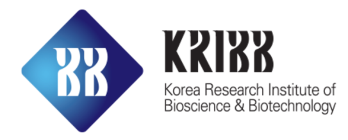
A selection of microbial cultures from the Korean Collection for Type Cultures.
When faced with a challenge such as a new pathogen, many researchers are turning to plant, animal, and human biological resources for answers as to how to prevent, diagnose and treat diseases. This is why organizations such as the Korea Research Institute of Bioscience and Biotechnology (KRIBB), in Daejon, are so vital for research into human health and disease.
KRIBB supports researchers accessing South Korea’s wealth of biological materials and data, from microbial cultures and plants. It enables researchers to scan for plant extracts that might have biological activity against a particular disease target, or to access a sample of a newly discovered bacteria that could help digest heavy metal pollution, for example. The organization has more than 650 full-time employees and a budget of more than ₩186 billion (about US$152 million) across four key areas — biomedical research, biomaterials research, bioinfrastructure, and national challenges.
Bringing biological resources together
South Korea’s 274 biological resource banks have recently been organized into 14 themed clusters, each led by a ‘hub bank’. This reorganization was initiated due to the issues with having so many biological resource centres spread around the country says TaeEun Jin, a principal scientist at KRIBB. “Some of them are quite huge, some of them are just a small laboratory,” Jin says. This variety in size meant not all biological resource centres were able to meet scientists’ needs. “In some surveys, many scientists said that there are many biological resource centres and the quality is too diverse.”
This diverse and large number of biological resource centres also presented a challenge for South Korea when it ratified the Nagoya Protocol in 2017. This agreement, under the auspices of the Convention on Biological Diversity, is designed to ensure that the benefits from using genetic resources are shared equally and used sustainably. The protocol prompted South Korean scientists to improve the quality of biological resources and reduce their dependence on foreign biological resources.
The first step towards this was the South Korean government’s development of a new strategy to manage biological resources, by clustering them into the 14 key areas — for example, the brain cluster, which is managed by the Korea Brain Bank. Jin and his team at the Korea Bioinformation Center (KOBIC), in Daejon, are responsible for supporting the operation of all of these clusters, ensuring that they comply with policies and legal regulations, and making it easy for researchers and industries to access the resources. KRIBB also serves as the hub bank for the plant and microbial clusters.

Korea Research Institute of Bioscience and Biotechnology headquarters in Daejon, South Korea.
Managing microbes
The hub bank focussed on microorganisms is KRIBB’s Korean Collection for Type Cultures (KCTC). This collection houses more than 40,000 biological resources; bacteria, viruses, fungi and algae, including more than 9,400 strains of aerobic gram-negative bacteria, 4,800 actinobacteria, 2,400 anaerobic bacteria and 1,400 microalgae. It also specializes in gut bacteria from humans, cows and pigs.
Under the International Code of Nomenclature of Prokaryotes (ICNP) rules, researchers who have identified a new strain of microbe must deposit their newly-discovered organism in at least two biological resource centres in two different countries before they can publish their discovery and have it recognized by the broader scientific community.
KCTC is also one of those facilities recognized as an International Depositary Authority (IDA) by the World Intellectual Property Organization. Researchers need to deposit their microbes to an IDA before claiming a patent. Deposits are made in the form of either freeze-dried samples or petri-dish samples, and once the sample is received, KCTC scientists culture the microorganism to make sure that it is still viable. Researchers also have to provide the marker gene sequence for the new strain, and KCTC itself also performs the sequencing to make sure the two sequences match.
Song-Gun Kim, a director of the biological resources centre, says there are three types of deposits that researchers can make with KCTC. If they make an open deposit, the process is free but the microbe is made available for anyone else to access and use. However, if a researcher or company wants to restrict access to their micro-organism strain, they can pay to do so. Similarly, companies who are depositing an organism for patent purposes are given extra levels of protection for their intellectual property to ensure it is secure.
KCTC also provides a range of other services. They have started a research programme to identify ‘secondary metabolites’, bioactive compounds produced by bacteria. The secondary metabolites of actinobacteria, a group of bacteria that are often found in soil, freshwater and marine environments, have been found to have a wide range of potential applications such as in antibiotics, pigments, vitamins and herbicides. As KCTC builds up a bank of these secondary metabolites, they too can be made available to researchers and Kim says the long-term plan is to identify and distribute purified secondary metabolite compounds from other bacteria as well as microalgae and archaea.
KCTC is also helping to train researchers, offering workshops to help them learn the skills needed to work with microorganisms. They offer one-day workshops for South Korean researchers and, before COVID-19, were also running more intensive six-week workshop programs for young international scientists. In this case, the scientists would bring a sample of an organism they were working on, and would be able to work alongside KCTC scientists as they go through the many processes involving in classifying and studying the organism.
But first and foremost, KCTC is a resource for researchers around the world, and Kim is proud of what its 28 staff members have achieved. “We have distributed 6,000-7,000 strains a year to both domestic an international labs,” he says. “We were the number one culture collection in the world from 2017 to 2021.”
Preserving plants
Another focus of KRIBB’s biological resources collections is plants — specifically, the bioactive compounds found in plants. While KRIBB has managed two banks of plant extracts (domestic since 2000; overseas since 2006), these were brought together into one institution — the Natural Product Central Bank (NPCB) — in 2021, that has within its collection the bioactive compound information on more than 1,700 species of native plants and more than 30,000 species of plants from abroad, mainly from tropical and sub-tropical regions. The NPCB also serves as the hub bank of the plant bioresource cluster.

Filtering the extracts of finely chopped plant material with 70% ethanol.© Natural Product Central Bank
Sei-Ryang Oh, director of the Natural Medicine Research Center at KRIBB, has long had an interest in the biochemical secrets of the plant world. “In South Korea, we have a lot of traditional medicines, so based on the clinical evidence from hundreds of years I tried to find out what are the active compounds in there,” says Oh. The purpose of the Natural Product Central Bank is to help other researchers and companies to develop phytomedicines, nutraceuticals or nutrafunctional cosmetics by providing a resource of bioactive, plant-derived extracts and their information.

Germinating seeds of a wild bean stored by the Natural Product Central Bank.
When plant samples are collected, the scientists at the NPCB process the plant specimens and extract bioactive compounds into 70% ethanol solution. These extracts are then put through primary and secondary screening to look for any biological activity against a range of known targets for disease. These screens are just looking for what Oh says is ‘twenty kinds of basic’ bioactivity, but “for specific bioactivity, the researchers are working on their own system.”
Alongside information about bioactive extracts, NPCB’s team of scientists record other essential information such as which part of the plant includes an active compound — whether it is the root, stem or leaf, for example — and exactly where the plant specimen is collected from. “The natural compounds are very fluctuating and are severely affected by environmental factors, so even in the same species if the place is different, the composition of extract is different,” Oh says.
With an almost endless array of plant species to choose from around the world, NPCB researchers have to decide which plant species to profile. One factor they consider is the commercialization potential for that species. For example, if the plant is only found in very few places and is difficult to cultivate, its commercial potential is reduced. Similarly, if a particular plant’s extract or compounds have already been published or patented, that makes it a less attractive proposition commercially and therefore potentially less of interest to the scientists who make use of NPCB’s resources.
Anyone, anywhere in the world will be able to benefit from the resources that KRIBB has to offer scientists and companies. KRIBB also maintains international collaborative ventures in countries such as China, Costa Rica, Indonesia and Vietnam, and Oh says those research partnerships ensure that all the scientists and countries involved benefit equally.

A sample of plants stored at Natural Product Central Bank.



 Focal Point on Biological Resources in South Korea
Focal Point on Biological Resources in South Korea